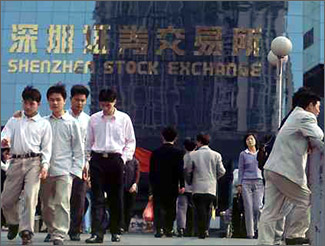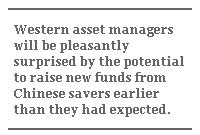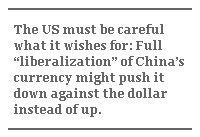The US and China: Friends or Foes? – Part II
The US and China: Friends or Foes? – Part II

BEIJING: Just after midnight on April 14 the People’s Bank of China released a public notice on opening numerous channels of the country’s capital account. As new policies are phased in, China’s financial economy will face the same globalization pressures that have buffeted and bolstered the manufacturing economy, with far-reaching consequences for China and the rest of the world.
China has long permitted its currency – the RMB – to be converted into foreign exchange for trading goods, while tightly restricting convertibility for portfolio investment – buying stocks and bonds, for instance. This is called having an open current account and closed capital account. This opened the country to world trade, but held off exposure to the vagaries of international financial flows. The policy is compatible with global rules, but as China’s economy matures, both the value of opening the capital account and the cost of keeping it closed increase.

By opening the current account, China boosted trade in goods, and thus quickly pinpointed its manufacturing strengths and weaknesses. This led to domestic adjustment to realize those strengths – mostly in making labor-intensive goods. With the financial sector still walled off from the world, it has not yet adjusted to reflect the relative strengths and weaknesses. The result: Chinese households can expect 2 percent or less return on their overall savings of almost $2 trillion while investors elsewhere would be disappointed with less than 5 percent. Long-term portfolio investments in mutual funds have lost value during the past decade. If exposed to competition from foreign money managers, Chinese financial service companies – and the People’s Bank which sets interest rates on deposits – would have to generate a better return or lose depositors to the likes of Fidelity, State Street and Neuberger Berman.
The Chinese bank’s adjustment of six foreign-exchange policies makes transmitting money out of China easier, with most opening some capital account flows. The adjustment allows every Chinese citizen to buy up to $20,000 in foreign exchange per year, which can be directed to foreign investments through qualified institutions. Mutual funds and securities companies can invest abroad a quota of their foreign-exchange holdings in China, while banks can do this and also convert a quota of RMB to foreign exchange. The game is open to insurance companies as well. Banks and insurers may be limited to investing in overseas fixed-income securities at first, a less volatile and lower returning asset class; but this could be eventually loosened. Meanwhile, back on the current account, converting RMB to foreign exchange to pay for foreign services – like environmental remediation, asset management, design and marketing – will be easier, and may bolster the trade surplus in services, which the US already runs with China.

These steps have many implications. First, previous talk of letting Chinese qualified domestic institutional investors convert money to invest abroad mostly concerned Hong Kong, to help the former colony’s performance under Chinese rule and direct savings into more Chinese firms listed there. But the steps just announced have no Hong Kong conditions. Western asset managers will be pleasantly surprised by the potential to raise new funds from Chinese savers earlier than they had expected. That they can do so directly with the Chinese without going through Hong Kong may also surprise a few.
Second, and significant for international relations, the prospect of substantial exchange of RMB into dollars to invest Chinese savings abroad (would you want 100 percent of your nest egg in Chinese stocks and bonds?) will change thinking about the right exchange rate for the RMB and dollar. The actual impact on the market for trading RMB and dollars will, in the near term, be small and not change any fundamentals; but the psychological effect of the prospect of $200 billion or $400 billion of RMB being cashed in for dollars over the next decade will temper currency speculators thinking RMB appreciation is a one-way bet.

Many estimates of RMB undervaluation in recent years suggested anywhere from 15 to 40 percent undervaluation, but all assumed a closed capital account. These estimates were debatable even under the assumption of a closed capital account. With the capital account partly open for significant capital outflows into dollars, euro and yen, the RMB’s long-term value is less clear. The US Congress and the Bush Administration will have to fine-tune their position on the issue, and be careful what they wish for: Full “liberalization” of China’s currency might actually push it down against the dollar instead of up.
There are considerable implications for the domestic Chinese financial sector. Households keep about $1.9 trillion in formal Chinese financial institutions; enterprises another $1.2 trillion. Depositors get a miserly rate of return – practically no capital gains at all after inflation. Chinese households are in effect being robbed, or taxed, depending on how you look at it, of the compounded interest they would enjoy in the US or Europe. Given a higher-return alternative, they will probably take it – up to the level permitted by quotas of course (there will be limits on outflows per institution just as there are for foreign institutions that convert money into China to invest in China stocks). This will put pressure on Chinese institutions to compete based on returns, as institutions do elsewhere, and think harder about where they in turn lend money and how disciplined they are in recovering investments. Both these notions – banks having to compete on returns, and borrowers in the state sector having to pay a market price for their capital – are fairly radical for China.

Savings go into banks and are recycled as loans to state companies in China, but they can also flow into the struggling stock exchange, directly or via mutual funds. So far this year, China’s stock markets have seen 30 percent gains and Shanghai brokers feel bullish. But no Chinese fund manager can compare his 10-year record against western average returns, and there will be enhanced pressure on Chinese stock funds to raise returns. Chinese investment funds will have to demand better performance from China’s listed companies. And if they can’t get it, they will have to maximize their options for investing in better governed companies elsewhere in the world.
A consequence of increased rates of return for savers is the wealth effect: Over time, as they enjoy better capital gains on deposited savings, Chinese households will need to save less than the supposed 30 to 40 percent of disposable income they put aside now. This would mean a major boost for consumption spending, a holy grail for Beijing and Washington alike as they look for ways to relieve bilateral trade tensions.
The implications begin now, but will unfold over many years, as the six policies are activated sequentially – the first, individual rights to buy $20,000 of foreign exchange, goes into force May 1. Implementation is contingent on stability in the Chinese financial sector, which is to say that these steps cannot lead to dangerous capital flight or they will be curtailed. But diversifying 10 percent of Chinese savings is possible in the decade ahead, which presently means $300 billion-plus, and 20 percent is not out of keeping with regional patterns. More important than the end point of the changes is the strong signal about the direction for China’s economy; that is what businesses and politicians must base decisions on in the here and now. All signals point to deeper interdependence with the world economy, broadening the scope and scale of economic reforms rather than slowing them.
Daniel H. Rosen is the principal with China Strategic Advisory based in New York and a visiting fellow with the Institute for International Economics in Washington DC.